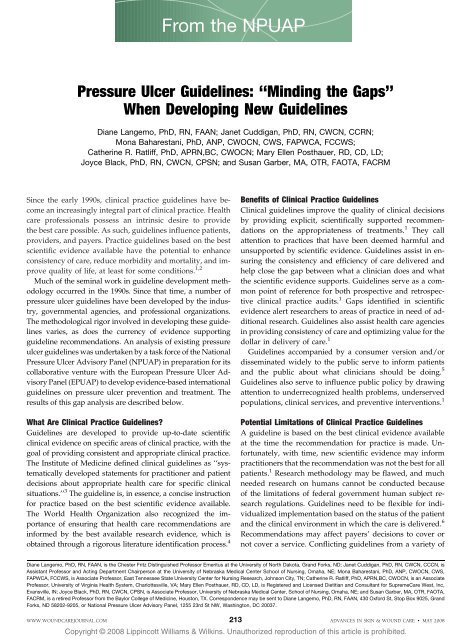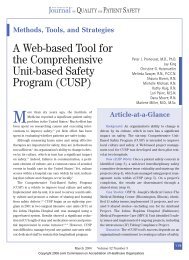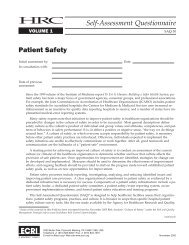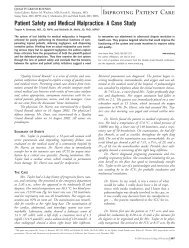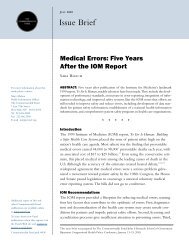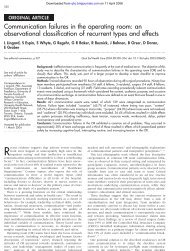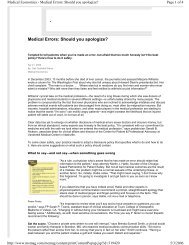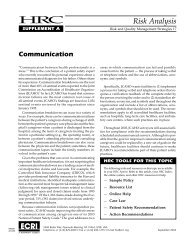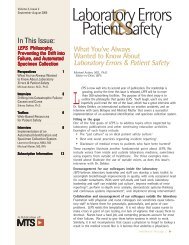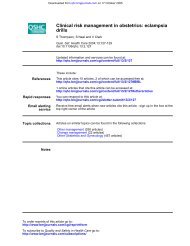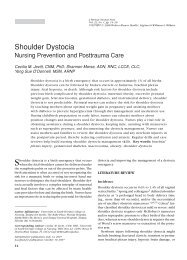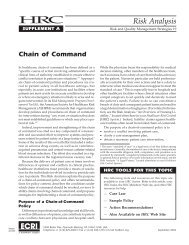Pressure Ulcer Guidelines: ''Minding the Gaps' - Lippincott Williams ...
Pressure Ulcer Guidelines: ''Minding the Gaps' - Lippincott Williams ...
Pressure Ulcer Guidelines: ''Minding the Gaps' - Lippincott Williams ...
- No tags were found...
You also want an ePaper? Increase the reach of your titles
YUMPU automatically turns print PDFs into web optimized ePapers that Google loves.
From <strong>the</strong> NPUAP<strong>Pressure</strong> <strong>Ulcer</strong> <strong>Guidelines</strong>: ‘‘Minding <strong>the</strong> Gaps’’When Developing New <strong>Guidelines</strong>Diane Langemo, PhD, RN, FAAN; Janet Cuddigan, PhD, RN, CWCN, CCRN;Mona Baharestani, PhD, ANP, CWOCN, CWS, FAPWCA, FCCWS;Ca<strong>the</strong>rine R. Ratliff, PhD, APRN,BC, CWOCN; Mary Ellen Posthauer, RD, CD, LD;Joyce Black, PhD, RN, CWCN, CPSN; and Susan Garber, MA, OTR, FAOTA, FACRMSince <strong>the</strong> early 1990s, clinical practice guidelines have becomean increasingly integral part of clinical practice. Healthcare professionals possess an intrinsic desire to provide<strong>the</strong> best care possible. As such, guidelines influence patients,providers, and payers. Practice guidelines based on <strong>the</strong> bestscientific evidence available have <strong>the</strong> potential to enhanceconsistency of care, reduce morbidity and mortality, and improvequality of life, at least for some conditions. 1,2Much of <strong>the</strong> seminal work in guideline development methodologyoccurred in <strong>the</strong> 1990s. Since that time, a number ofpressure ulcer guidelines have been developed by <strong>the</strong> industry,governmental agencies, and professional organizations.The methodological rigor involved in developing <strong>the</strong>se guidelinesvaries, as does <strong>the</strong> currency of evidence supportingguideline recommendations. An analysis of existing pressureulcer guidelines was undertaken by a task force of <strong>the</strong> National<strong>Pressure</strong> <strong>Ulcer</strong> Advisory Panel (NPUAP) in preparation for itscollaborative venture with <strong>the</strong> European <strong>Pressure</strong> <strong>Ulcer</strong> AdvisoryPanel (EPUAP) to develop evidence-based internationalguidelines on pressure ulcer prevention and treatment. Theresults of this gap analysis are described below.What Are Clinical Practice <strong>Guidelines</strong>?<strong>Guidelines</strong> are developed to provide up-to-date scientificclinical evidence on specific areas of clinical practice, with <strong>the</strong>goal of providing consistent and appropriate clinical practice.The Institute of Medicine defined clinical guidelines as ‘‘systematicallydeveloped statements for practitioner and patientdecisions about appropriate health care for specific clinicalsituations.’’ 3 The guideline is, in essence, a concise instructionfor practice based on <strong>the</strong> best scientific evidence available.The World Health Organization also recognized <strong>the</strong> importanceof ensuring that health care recommendations areinformed by <strong>the</strong> best available research evidence, which isobtained through a rigorous literature identification process. 4Benefits of Clinical Practice <strong>Guidelines</strong>Clinical guidelines improve <strong>the</strong> quality of clinical decisionsby providing explicit, scientifically supported recommendationson <strong>the</strong> appropriateness of treatments. 1 They callattention to practices that have been deemed harmful andunsupported by scientific evidence. <strong>Guidelines</strong> assist in ensuring<strong>the</strong> consistency and efficiency of care delivered andhelp close <strong>the</strong> gap between what a clinician does and what<strong>the</strong> scientific evidence supports. <strong>Guidelines</strong> serve as a commonpoint of reference for both prospective and retrospectiveclinical practice audits. 1 Gaps identified in scientificevidence alert researchers to areas of practice in need of additionalresearch. <strong>Guidelines</strong> also assist health care agenciesin providing consistency of care and optimizing value for <strong>the</strong>dollar in delivery of care. 1<strong>Guidelines</strong> accompanied by a consumer version and/ordisseminated widely to <strong>the</strong> public serve to inform patientsand <strong>the</strong> public about what clinicians should be doing. 5<strong>Guidelines</strong> also serve to influence public policy by drawingattention to underrecognized health problems, underservedpopulations, clinical services, and preventive interventions. 1Potential Limitations of Clinical Practice <strong>Guidelines</strong>A guideline is based on <strong>the</strong> best clinical evidence availableat <strong>the</strong> time <strong>the</strong> recommendation for practice is made. Unfortunately,with time, new scientific evidence may informpractitioners that <strong>the</strong> recommendation was not <strong>the</strong> best for allpatients. 1 Research methodology may be flawed, and muchneeded research on humans cannot be conducted becauseof <strong>the</strong> limitations of federal government human subject researchregulations. <strong>Guidelines</strong> need to be flexible for individualizedimplementation based on <strong>the</strong> status of <strong>the</strong> patientand <strong>the</strong> clinical environment in which <strong>the</strong> care is delivered. 6Recommendations may affect payers’ decisions to cover ornot cover a service. Conflicting guidelines from a variety ofDiane Langemo, PhD, RN, FAAN, is <strong>the</strong> Chester Fritz Distinguished Professor Emeritus at <strong>the</strong> University of North Dakota, Grand Forks, ND; Janet Cuddigan, PhD, RN, CWCN, CCCN, isAssistant Professor and Acting Department Chairperson at <strong>the</strong> University of Nebraska Medical Center School of Nursing, Omaha, NE; Mona Baharestani, PhD, ANP, CWOCN, CWS,FAPWCA, FCCWS, is Associate Professor, East Tennessee State University Center for Nursing Research, Johnson City, TN; Ca<strong>the</strong>rine R. Ratliff, PhD, APRN,BC, CWOCN, is an AssociateProfessor, University of Virginia Health System, Charlottesville, VA; Mary Ellen Posthauer, RD, CD, LD, is Registered and Licensed Dietitian and Consultant for SupremeCare West, Inc,Evansville, IN; Joyce Black, PhD, RN, CWCN, CPSN, is Associate Professor, University of Nebraska Medical Center, School of Nursing, Omaha, NE; and Susan Garber, MA, OTR, FAOTA,FACRM, is a retired Professor from <strong>the</strong> Baylor College of Medicine, Houston, TX. Correspondence may be sent to Diane Langemo, PhD, RN, FAAN, 430 Oxford St, Stop Box 9025, GrandForks, ND 58202-9205, or National <strong>Pressure</strong> <strong>Ulcer</strong> Advisory Panel, 1255 23rd St NW, Washington, DC 20037.WWW.WOUNDCAREJOURNAL.COM 213 ADVANCES IN SKIN & WOUND CARE & MAY 2008Copyright @ 2008 <strong>Lippincott</strong> <strong>Williams</strong> & Wilkins. Unauthorized reproduction of this article is prohibited.
From <strong>the</strong> NPUAPsources can confuse practitioners. 7 Outdated recommendationshave <strong>the</strong> potential of promoting outdated care. Lastly,guidelines that conclude a treatment or procedure maynot be beneficial can be dangerous and may limit approvaland/or funding for future research on <strong>the</strong> topic. 1Updating <strong>Guidelines</strong>In 2001, Shekelle et al 8 reviewed 17 guidelines publishedby <strong>the</strong> Agency for Healthcare Research and Quality andestimated that 90% remained valid after 3.6 years and thatnearly half were outdated in 5.8 years. Based on this work,<strong>the</strong>y recommended guidelines be reassessed on a 3-year cycle.Given that most pressure ulcer guidelines are older than3 years, it was determined that existing guidelines needed tobe examined for gaps to identify areas in current guidelinesthat are deficient. This was done in preparation for <strong>the</strong> developmentof collaborative international guidelines.MethodologySearch StrategyA search was conducted for guidelines related to pressureulcer prevention and treatment. Seven sets of guidelines containingrecommendations for both prevention and treatmentwere identified. Two guidelines contained all or some aspectsof prevention, but not treatment. Two guidelines addressedtreatment only. The Web siteVhttp://www.guideline.govVyielded <strong>the</strong> majority of guidelines. O<strong>the</strong>r strategies includedsearches of electronic databases, bibliographies of publishedarticles, and contacts with international colleagues. This reviewwas restricted to guidelines written in or translated intoEnglish. The authors would welcome English translationsof o<strong>the</strong>r guidelines as <strong>the</strong>y undertake international guidelinedevelopment work. Only nonindustry–sponsored guidelineswere included. <strong>Pressure</strong> ulcer prevention and treatmentguidelines selected for critique included <strong>the</strong> following: Agencyfor Healthcare Research and Quality (AHRQ [formerly <strong>the</strong>Agency for Healthcare Policy and Research]) 9,10 ; EPUAP 11–13 ;Wound, Ostomy and Continence Nurses Society 14 ; RegisteredNurses’ Association of Ontario 15,16 ; Singapore Ministryof Health 17 ; Paralyzed Veterans of America 18 ; NationalInstitute for Clinical Excellence 19 ; The University of IowaGerontological Nursing Interventions Research Center 20 ;<strong>the</strong> American Medical Directors Association 21,22 ; <strong>the</strong> WoundHealing Society 23 ; and <strong>the</strong> Australian Wound ManagementAssociation. 24Data ExtractionDescriptive information extracted for each guideline included<strong>the</strong> year of development and year of last review, <strong>the</strong>type of developing group, if <strong>the</strong> guidelines were adaptedfrom ano<strong>the</strong>r source, source of funding for <strong>the</strong> developmentprocess, financial disclosures/conflict of interest disclosuresby panel, disciplines represented by panel members, targetpatient population(s), target setting(s), target clinical specialty,and intended users. Guideline objectives and majoroutcomes considered were also reviewed. Whe<strong>the</strong>r a costanalysis was performed was also considered.The authors developed guideline analysis criteria thatsyn<strong>the</strong>sized <strong>the</strong> following: <strong>the</strong> National Guideline Clearinghousecriteria used to compare and contrast guidelines on itsWeb site (http://www.guideline.gov), criteria for methodologicalrigor from <strong>the</strong> Appraisal of <strong>Guidelines</strong> Research andEvaluation Instrument that were not already included in <strong>the</strong>Clearinghouse criteria (http://www.agreecollaboration.org),and recommendations from NPUAP board members identifyingadditional guideline characteristics and critical contentnecessary for comprehensive, evidence-based, internationalguidelines for <strong>the</strong> prevention and treatment of pressureulcers.Tables were developed using <strong>the</strong> guideline appraisal criteriaitemized in Figure 1. Through a series of phone conferences,<strong>the</strong> authors reached a common understanding of each criterion.Each author was <strong>the</strong>n assigned guidelines to review,extracting data to complete <strong>the</strong> table for his or her respectiveguidelines. Data extraction for each guideline was <strong>the</strong>n reviewedfor accuracy by one of <strong>the</strong> o<strong>the</strong>r authors. Authors alsoidentified whe<strong>the</strong>r critical content for prevention and treatmentwas included in each guideline (Figures 2 and 3).The completed table allowed <strong>the</strong> group to quickly compareand contrast <strong>the</strong> methodological rigor involved in guidelinedevelopment, <strong>the</strong> currency and comprehensiveness of supportingevidence, and inclusion of critical content. Using amodified Delphi technique, gaps in pressure ulcer preventionand treatment guidelines were identified.Results<strong>Pressure</strong> ulcer guidelines meeting inclusion criteria for thisanalysis were appraised by <strong>the</strong> authors. Some of <strong>the</strong> guidelineshad been revised since <strong>the</strong>ir inception, whereas o<strong>the</strong>rshad not. A comprehensive body of knowledge existed in<strong>the</strong> current guidelines but was determined to be timely onlyto <strong>the</strong> date each guideline was published and <strong>the</strong> extentof <strong>the</strong> review of literature completed. Overall, <strong>the</strong> pressureulcer guidelines were well conceptualized, organized, andclinically grounded. This group of reviewers determinedthat <strong>the</strong> processes for selecting material to be included in<strong>the</strong> guidelines could have been more stringent in somecases. Many of <strong>the</strong> guidelines referred to <strong>the</strong> AHRQ preventionand treatment guidelines, refining and extendingrecommendations based on current literature and <strong>the</strong> needsof special populations.ADVANCES IN SKIN & WOUND CARE & VOL. 21 NO. 5 214 WWW.WOUNDCAREJOURNAL.COMCopyright @ 2008 <strong>Lippincott</strong> <strong>Williams</strong> & Wilkins. Unauthorized reproduction of this article is prohibited.
From <strong>the</strong> NPUAPFigure 1.SUMMARY OF GUIDELINE APPRAISAL CRITERIA& Not all care guidelines were multidisciplinary-focused, nor were<strong>the</strong>y developed by a multidisciplinary team of care providers.& The target population for most guidelines was adults and/orolder adults. Special populations were included in <strong>the</strong> ParalyzedVeterans of America guideline, 18 focusing on personswith spinal cord injury, and <strong>the</strong> American Medical DirectorsAssociation guideline, 21,22 focusing on older adults andresidents of long-term-care facilities. Although most guidelinesprovide broad recommendations that could be appliedto multiple populations, <strong>the</strong>re are some unique aspects ofpressure ulcer prevention and treatment that should beinvestigated and developed for specialty populations, suchas neonatal, pediatric, bariatric, geriatric, palliative care, andcritical care patients. Future guidelines should address <strong>the</strong>unique needs of <strong>the</strong>se specialty populations.& Few guidelines contained a cost-benefit analysis.& The EPUAP guidelines were <strong>the</strong> first multinational collaborativeeffort to produce pressure ulcer guidelines; however,a broader international perspective is still needed.& Methodological rigor varied among guidelines. Some guidelinesidentified explicit search strategies, inclusion-exclusioncriteria, methods for data extraction into evidence tables, andREDEFINING THEBOUNDARIES OF MEDICINENumerous gaps were identified in some or all sets ofguidelines. More specifically, <strong>the</strong> group identified <strong>the</strong> followingareas as weaknesses in some or all of <strong>the</strong> guidelines:& <strong>Guidelines</strong> need to be based on a thorough, comprehensivereview and syn<strong>the</strong>sis of <strong>the</strong> literature up to <strong>the</strong> time of publication.The science of pressure ulcer treatment has movedforward since some guidelines were developed, and multiplenew products and technologies now exist that need tobe addressed in <strong>the</strong> guidelines. The Wound, Ostomy andContinence Nurses Society guidelines 14 and <strong>the</strong> WoundHealing Society guidelines 22 contain <strong>the</strong> most up-to-dateinformation; however, nei<strong>the</strong>r was based on a completelythorough review of <strong>the</strong> literature.& It would be most helpful for clinicians if treatmentguidelines were organized according to a framework or setof principles (eg, principles of wound bed preparation,incorporation of some discussion of newer research to support<strong>the</strong>se principles).Geisinger Medical Center, Danville, PA, seeks a Director of <strong>the</strong>Wound Clinic. The qualified physician will be board certified inDermatology, Internal Medicine, or Family Medicine with an interestin wound care.About this position:• The Director will be responsible for patient care and oversightof <strong>the</strong> Wound Clinic, located within <strong>the</strong> Departmentof Dermatology• The clinic currently includes 5 Dermatology nurses,1 dermatologist and 1 podiatrist• Research opportunities are available in cooperation with <strong>the</strong>Geisinger Center for Health Research• Nine dermatology residents rotate through <strong>the</strong> clinicFor more information, please contact Lori Surak,Physician Recruiter, at 1-800-845-7112, email ljsurak@geisinger.eduor visit www.geisinger.org/docjobsWWW.WOUNDCAREJOURNAL.COM 215 ADVANCES IN SKIN & WOUND CARE & MAY 2008Copyright @ 2008 <strong>Lippincott</strong> <strong>Williams</strong> & Wilkins. Unauthorized reproduction of this article is prohibited.
From <strong>the</strong> NPUAPFigure 2.CONTENT INVENTORY FOR PRESSUREULCER PREVENTION GUIDELINES& Both internal and external, as well as legal, reviews areneeded. Comments from all internal and external reviewersneed to be compiled and acted upon.& Not all guidelines contained a clinical algorithm that <strong>the</strong>group of reviewers believed would be beneficial to include.& Guidance for implementation of guidelines was lackingin some instances. <strong>Guidelines</strong> tend to provide broad recommendationsthat can be applied to multiple patientpopulations in diverse settings. Translating guideline recommendationsinto <strong>the</strong> specific protocols, educational strategies,and practices that will work in specific settings andpopulations is often challenging. The companion implementationguidelines developed by <strong>the</strong> American MedicalFigure 3.CONTENT INVENTORY FOR PRESSUREULCER TREATMENT GUIDELINESquality ratings of individual studies to inform guideline developers.O<strong>the</strong>rs merely used a committee consensus process.& Published meta-analyses and comprehensive literature reviewsare an increasingly common source of supporting evidencefor guidelines. Many of <strong>the</strong>se reviews are excellent(eg, <strong>the</strong> Cochrane Reviews). However, a careful examinationof <strong>the</strong> methodologies used to create <strong>the</strong>se reviews is essentialbefore using <strong>the</strong>m to make recommendations for patientcare. Was <strong>the</strong> review comprehensive? Is <strong>the</strong>re any bias in <strong>the</strong>selection and review of studies? What statistical methodswere used for meta-analysis?& Rating schemas varied among guidelines. The ‘‘strengthof evidence’’ supporting a given guideline recommendationwas often based on a ‘‘design hierarchy’’ that placed <strong>the</strong>randomized controlled clinical trial at <strong>the</strong> top. The quality of<strong>the</strong> study, regardless of design, was considered by some,but not all, guideline developers. ‘‘Strength of recommendation’’rating schemes tend to address <strong>the</strong> quality and designof supporting studies while explicitly identifying and acknowledging<strong>the</strong> role of clinical expertise in providing patient care.The ‘‘strength of recommendation’’ rating often brings <strong>the</strong>science to <strong>the</strong> bedside by asking: ‘‘After a careful and comprehensiveanalysis of current science and clinical expertise, whatare <strong>the</strong> best recommendations we can offer our patients?’’ADVANCES IN SKIN & WOUND CARE & VOL. 21 NO. 5 216 WWW.WOUNDCAREJOURNAL.COMCopyright @ 2008 <strong>Lippincott</strong> <strong>Williams</strong> & Wilkins. Unauthorized reproduction of this article is prohibited.
From <strong>the</strong> NPUAPDirectors Association are an excellent example of waysto bridge this translational gap. Individual facilities andagencies are ultimately responsible for implementation,education, and continuous quality improvement.& Patient education information was included in only a fewsets of guidelines.& Seamless care between care settings is an importantconcept and was not addressed in guidelines reviewed.& Characteristics and properties of support surfaces wereincluded but could be better delineated, particularly in termsof selection of <strong>the</strong> appropriate surface for a patient with aparticular type of pressure ulcer. The NPUAP has standardizedterms and definitions related to support surfaces, and<strong>the</strong>se need to be incorporated and updated as new technologiesemerge (http://www.npuap.org/NPUAP_S3I_TD.pdf).& Mention of nutrition was lacking in most guidelines.Recommendations from those guidelines addressing nutritioncould be more specific and updated based on newerscientific evidence.& Implementation of all recommendations should be basedon patient goals and preferences.& Several ethical issues are inherent within <strong>the</strong> guidelines:truth telling and respect for individual wishes (palliative andsupportive versus healing and restorative treatment focus),distributive justice (availability of more expensive and technologicallyadvanced products in poor and underservedpopulations), distributive justice and beneficence (<strong>the</strong> responsibilityof all health care providers to provide <strong>the</strong> mostcost-effective and efficacious treatment for <strong>the</strong>ir patients,wisely utilizing resources to achieve <strong>the</strong> ‘‘most good for <strong>the</strong>greatest number’’ of patients).The FutureThe EPUAP and <strong>the</strong> NPUAP have been working on a collaborativeinternational project to develop internationalpressure ulcer prevention and treatment guidelines. Literaturesearches will be performed, evidence tables will beprepared, guidelines will be drafted, and <strong>the</strong> draft guidelinerecommendations will be distributed to wound care providersand researchers and o<strong>the</strong>r stakeholders throughout<strong>the</strong> world for input.A Web site has been developed for communication amonginternational guideline developers as <strong>the</strong>y review and analyze<strong>the</strong> scientific evidence on pressure ulcer prevention andtreatment. As literature reviews and guidelines are drafted,<strong>the</strong>y will be available on <strong>the</strong> Web site for stakeholder reviewand recommendations. The EPUAP and NPUAP Web siteshave links to <strong>the</strong> guideline Web site (http://www.EPUAP.org, http://www.NPUAP.org). It is anticipated that <strong>the</strong>senew international pressure ulcer prevention and treatmentguidelines will be completed by late 2008.Evidence supporting <strong>the</strong> international guidelines will bepresented at <strong>the</strong> World Union of Wound Healing Societies conferencein Toronto, Canada, in June 2008. Members of <strong>the</strong> internationalwound care community will be invited to comment onvarious aspects of <strong>the</strong> guidelines during this conference.&References1. Woolf SH, Grol R, Hutchinson A, Eccles M, et al. Potential benefits, limitations, and harmsof clinical guidelines. BMJ 1999;318:527-30.2. Chassin MR, Brook RH, Park RE, et al. Variations in <strong>the</strong> use of medical and surgicalservices by <strong>the</strong> Medicare population. N Engl J Med 1986;314;285-90.3. Field MJ, Lohr KN, eds. Clinical Practice <strong>Guidelines</strong>: Directions for a New Program.Washington, DC: National Academy Press; 1990.4. Global Programme on Evidence for Health Policy. <strong>Guidelines</strong> for WHO <strong>Guidelines</strong>.Geneva, Switzerland: World Health Organization; 2003 (EIP/GPE/EQC/2003.1).5. Entwistle VA, Watt IS, Davis H, et al. Developing information materials to present findingsof technology assessments to consumers. The experience of <strong>the</strong> NHS Centre for Reviewsand Dissemination. Int J Technol Assess Health Care 1998;14:47-70.6. Woolf SH. Shared decision-making: <strong>the</strong> case for letting patients decide which choice isbest. J Fam Pract 1997;45:205-8.7. Feder G. Management of mild hypertension: which guidelines to follow? BMJ 1994;308:470-1.8. Shekelle P, Eccles M, Grimshaw JM, et al. When should clinical guidelines be updated?BMJ 2001;323:155-7.9. Agency for Healthcare Policy and Research. <strong>Pressure</strong> <strong>Ulcer</strong>s in Adults: Prediction andPrevention. Clinical Practice Guideline No. 3. AHCPR Publication No. 92-0047. Rockville,MD: Public Health Service, US Dept of Health and Human Services, AHCPR; 1992.10. Agency for Healthcare Policy and Research. Treatment of <strong>Pressure</strong> <strong>Ulcer</strong>s. ClinicalPractice Guideline No. 15. AHCPR Publication No. 95-0652, Rockville, MD: Public HealthService, US Dept of Health and Human Services, AHCPR; 1994.11. European <strong>Pressure</strong> <strong>Ulcer</strong> Advisory Panel. <strong>Pressure</strong> <strong>Ulcer</strong> Prevention Guideline. Oxford:EPUAP; 1998.12. European <strong>Pressure</strong> <strong>Ulcer</strong> Advisory Panel. <strong>Pressure</strong> <strong>Ulcer</strong> Treatment <strong>Guidelines</strong>. Oxford:EPUAP; 1998.13. European <strong>Pressure</strong> <strong>Ulcer</strong> Advisory Panel Nutrition <strong>Guidelines</strong> for <strong>Pressure</strong> <strong>Ulcer</strong>Prevention and Treatment. Oxford: EPUAP; 2003.14. Wound, Ostomy and Continence Nurses Society. Guideline for Prevention and Managementof <strong>Pressure</strong> <strong>Ulcer</strong>s. WOCN Clinical Practice Guideline Series. Glenview, IL: WOCN; 2003.15. Registered Nurses’ Association of Ontario. Risk Assessment & Prevention of <strong>Pressure</strong><strong>Ulcer</strong>s. Publication No. 0-920166-57-1. Toronto, Ontario, Canada: RNAO; 2005.16. Registered Nurses’ Association of Ontario. Assessment and Management of Stage I to IV<strong>Pressure</strong> <strong>Ulcer</strong>s. Toronto, Ontario, Canada: RNAO; 2002.17. Singapore Ministry of Health. Prediction and Prevention of <strong>Pressure</strong> <strong>Ulcer</strong>s in Adults.Singapore: Singapore Ministry of Health; 2002.18. Consortium for Spinal Cord Medicine. Clinical Practice <strong>Guidelines</strong>. <strong>Pressure</strong> <strong>Ulcer</strong>Prevention and Treatment Following Spinal Cord Injury: A Clinical Practice Guideline forHealth Care Professionals. Washington, DC: Paralyzed Veterans of America; 2001.19. National Institute for Clinical Excellence. <strong>Pressure</strong> <strong>Ulcer</strong> Risk Assessment and Prevention,Including <strong>the</strong> Use of <strong>Pressure</strong>-Relieving Devices (Beds, Mattresses, and Overlays) for <strong>the</strong>Prevention of <strong>Pressure</strong> <strong>Ulcer</strong>s in Primary and Secondary Care. ISBN 1-84257-407-8.London: NICE; 2003.20. Folkedahl BA, Frantz R, Goode C. Evidence-Based Practice Guideline: Treatment of<strong>Pressure</strong> <strong>Ulcer</strong>s. Iowa City, IA: The University of Iowa Gerontological Nursing InterventionsResearch Center; 1997. Available at: http://www.guideline.gov/summary/summary.aspx?doc_id=7006. Last accessed March 18, 2008.21. American Medical Directors Association. <strong>Pressure</strong> <strong>Ulcer</strong>s, Clinical Practice <strong>Guidelines</strong>.Columbia, MD: American Medical Directors Association; 1996.22. American Medical Directors Association. <strong>Pressure</strong> <strong>Ulcer</strong> Therapy Companion, ClinicalPractice Guideline. Columbia, MD: American Medical Directors Association; 1999.23. Whitney J, Phillips L, Aslam R, et al. <strong>Guidelines</strong> for <strong>the</strong> treatment of pressure ulcers.Wound Repair Regen 2006;14:663.24. Australian Wound Management <strong>Pressure</strong> <strong>Ulcer</strong> Interest Subcommittee. Clinical Practice<strong>Guidelines</strong> for <strong>the</strong> Prediction and Prevention of <strong>Pressure</strong> <strong>Ulcer</strong>s. West Leederville, WA:Cambridge Publications; 2001. Available at: http://www.awma.com.au/publications/publications.php#clinical. Last accessed March 10, 2008.WWW.WOUNDCAREJOURNAL.COM 217 ADVANCES IN SKIN & WOUND CARE & MAY 2008Copyright @ 2008 <strong>Lippincott</strong> <strong>Williams</strong> & Wilkins. Unauthorized reproduction of this article is prohibited.


